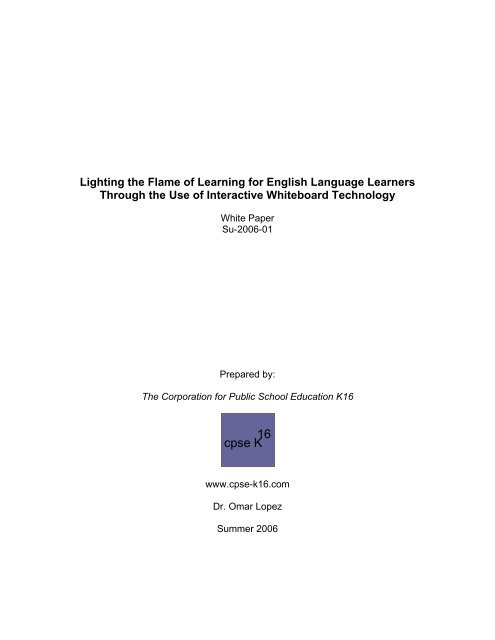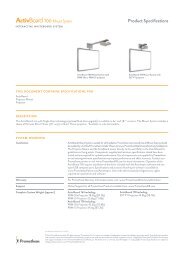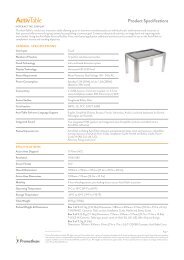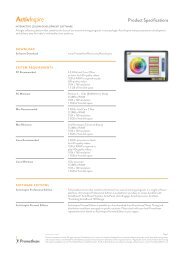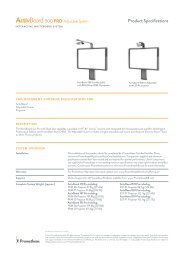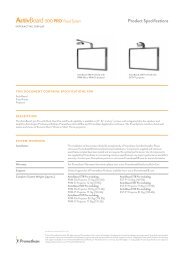Lighting the Flame of Learning for English Language ... - Promethean
Lighting the Flame of Learning for English Language ... - Promethean
Lighting the Flame of Learning for English Language ... - Promethean
Create successful ePaper yourself
Turn your PDF publications into a flip-book with our unique Google optimized e-Paper software.
<strong>Lighting</strong> <strong>the</strong> <strong>Flame</strong> <strong>of</strong> <strong>Learning</strong> <strong>for</strong> <strong>English</strong> <strong>Language</strong> LearnersThrough <strong>the</strong> Use <strong>of</strong> Interactive Whiteboard TechnologyWhite PaperSu-2006-01Prepared by:The Corporation <strong>for</strong> Public School Education K16cpse K 16www.cpse-k16.comDr. Omar LopezSummer 2006
<strong>Lighting</strong> <strong>the</strong> <strong>Flame</strong> <strong>of</strong> <strong>Learning</strong><strong>for</strong> <strong>English</strong> <strong>Language</strong> LearnersInteractive Whiteboard Technology:<strong>Lighting</strong> <strong>the</strong> <strong>Flame</strong> <strong>of</strong> <strong>Learning</strong> <strong>for</strong> <strong>English</strong> <strong>Language</strong> LearnersEducators have <strong>for</strong> many years looked at computer technology as a potential source <strong>for</strong>meeting <strong>the</strong> learning needs <strong>of</strong> ELLs.Throughout <strong>the</strong> 1960s and 1970s, a behaviorist model <strong>for</strong> computer-based instructionexisted in which language instruction was introduced in <strong>the</strong> <strong>for</strong>m <strong>of</strong> drill and practice.Over <strong>the</strong> years, research shows that such isolated drill and practice was not an effectiveway to improve students' academic achievement. During <strong>the</strong> 1980s and 1990s, <strong>the</strong>focus shifted to <strong>the</strong> cognitive and language pr<strong>of</strong>iciency needs <strong>of</strong> ELLs in which contentbasedteaching became a widely accepted means <strong>of</strong> teaching <strong>English</strong> (Butler-Pascoe &Wiburg, 2003).Today's technology-based instruction emphasizes students constructing meaning basedon a high degree <strong>of</strong> interactivity among students, between students and curriculum, andbetween students and teacher. An emerging class <strong>of</strong> technology that <strong>of</strong>fers enormouspotential in generating <strong>the</strong>se interactions is interactive whiteboards or IWBs. An IWB isa large, interactive whiteboard that is connected to a digital projector and a computer.The projector displays <strong>the</strong> image from <strong>the</strong> computer screen on <strong>the</strong> board. The computercan <strong>the</strong>n be controlled by touching <strong>the</strong> board, with a special pen. These active classroomscan address <strong>the</strong> five instructional principles outlined earlier in a variety <strong>of</strong> ways.<strong>Learning</strong> builds on previous experiences and <strong>the</strong>re<strong>for</strong>e, ELL teachers need toincorporate ELLs’ prior knowledge, culture, interests, and experiences in new learning.Active classrooms can support many effective instructional strategies <strong>for</strong> ELLs, such asusing nonlinguistic representation, helping students recognize patterns, and giving studentsopportunities to practice communicating complex ideas. However, teachers can also useIWBs to link ELLs’ prior experience with new learning by bringing ELLs’ home culture,interests, and experiences into <strong>the</strong> classroom through digital images, music, andmultimedia. The result is that ELL teachers can use Active classrooms to create learningenvironments where ELLs can construct <strong>the</strong>ir own knowledge as teachers scaffoldstudents’ learning with new content knowledge.<strong>Learning</strong> takes place in a social setting and <strong>the</strong>re<strong>for</strong>e, ELL teachers need to provideopportunities <strong>for</strong> ELL student-interactions.Active classrooms provide teachers with many opportunities to create social settings wherestudent interactions can result in learning. For example, research has shown thatopportunities <strong>for</strong> students to use an IWB to present and discuss <strong>the</strong>ir own work with o<strong>the</strong>rstudents, or become involved in a class-wide activities, e.g. a class activote, improves <strong>the</strong>irattention and engagement in <strong>the</strong> learning process (BECTA, 2003; Burden, 2002; Miller &Glover, 2002).4
<strong>Lighting</strong> <strong>the</strong> <strong>Flame</strong> <strong>of</strong> <strong>Learning</strong><strong>for</strong> <strong>English</strong> <strong>Language</strong> LearnersCentral to <strong>the</strong>se student interactions are IWB features that allow students to annotate,conceal, manipulate, move and zoom in on or focus on images, including text (Bell,2002; Levy, 2002; Thomas, 2003). For example, students in one study used IWBs tomanipulate and color in visual images that resulted in better understanding <strong>of</strong> fractionsand percentages, measurement <strong>of</strong> angles, and trans<strong>for</strong>mation <strong>of</strong> shapes (Edwards etal., 2002).This is <strong>the</strong> reason Kennewell (2001) argues that students must be allowed to use IWBs<strong>the</strong>mselves. Active classrooms in an interactive group-setting motivate studentsbecause <strong>the</strong> students’ interactions within <strong>the</strong> context <strong>of</strong> IWB features make lessonsmore enjoyable and interesting, resulting in improved attention and behavior essential tolearning (Beeland, 2002).Knowledge taught in a variety <strong>of</strong> contexts is more likely to support learning across studentswith diverse learning needs and <strong>the</strong>re<strong>for</strong>e, ELL teachers need to integrate ELL strategiesin different contexts.Active classroom technology-features can compensate <strong>for</strong> many differences inbackground that ELLs bring to <strong>the</strong> classroom and helps develop engaged learningenvironments that encourage students to learn. Many teachers that use IWBs in <strong>the</strong>irclassroom claim that such technology promotes student learning because <strong>of</strong> itsmultimedia and multi-sensory capacity. For example, teachers have reported that anIWB’s capacity to present stimulating visual images enhances students’ recall <strong>of</strong>in<strong>for</strong>mation from being able to still “see” <strong>the</strong> images in <strong>the</strong>ir mind even after completing<strong>the</strong> lesson (Burden, 2002).Project-based learning, <strong>the</strong>matic instruction, and cooperative grouping are strategiesthat teacher can use to engage ELLs. Such strategies give students opportunities to talkabout shared learning experiences and to engage in hands-on, experiential learningexperiences that promote learning <strong>of</strong> new material. Active classrooms can help ELLs inthis latter process by making available multimedia, simulations, and modeling.The active classroom’s capacity to present a range <strong>of</strong> multimedia resources efficiently isalso argued to help students learn. This is not only because <strong>the</strong>re is more in<strong>for</strong>mationavailable, <strong>the</strong>re is also a wider variety <strong>of</strong> in<strong>for</strong>mation so that ideas and concepts becomemore tangible and students find <strong>the</strong> concepts easier to assimilate (Levy, 2002).Moreover, teachers report that <strong>the</strong>y can more easily accommodate a wider range <strong>of</strong>student learning styles using IWBs, when needed <strong>for</strong> particular students’ needs (Bell,2002; Billard, 2002).Connected, organized and relevant in<strong>for</strong>mation supports students learning <strong>of</strong> knowledgebut also helps <strong>the</strong>m develop higher-order thinking skills. Thus, ELL teachers need tocontextualize instruction and use such strategies like graphic organizers that supportELLs’ development <strong>of</strong> higher-order skills.5
<strong>Lighting</strong> <strong>the</strong> <strong>Flame</strong> <strong>of</strong> <strong>Learning</strong><strong>for</strong> <strong>English</strong> <strong>Language</strong> LearnersRecommendations <strong>for</strong> Educators and Technology Decision MakersThe purpose <strong>for</strong> using IWBs in <strong>the</strong> classroom is to enable access to and use <strong>of</strong> digitalresources <strong>for</strong> <strong>the</strong> benefit <strong>of</strong> <strong>the</strong> whole class while preserving <strong>the</strong> role <strong>of</strong> <strong>the</strong> teacher inguiding and monitoring learning. Active classrooms support many effective strategies,such as using nonlinguistic representation, helping students recognize patterns, giving<strong>the</strong>m opportunities to practice communicating complex ideas, allowing teachers toparticipate in ELL instructional chat rooms, and bringing <strong>the</strong>ir home culture into <strong>the</strong>classroom through digital images, music, and o<strong>the</strong>r multimedia.Still, educators should take great care when planning <strong>for</strong> an active classroom-basedclassroom. One <strong>of</strong> <strong>the</strong> most frequent issues raised by both teachers and students is <strong>the</strong>need <strong>for</strong> adequate training in order to use IWBs to <strong>the</strong>ir full potential. Teachers’inexperience in setting up equipment and in manipulating features on <strong>the</strong> board, leadingto lesson disruption is a concern <strong>for</strong> both teachers and students (Levy, 2002). Teacherbuy-in into <strong>the</strong> use <strong>of</strong> IWBs in <strong>the</strong> classroom is ano<strong>the</strong>r issue. Some researchers havehighlighted that even when a teacher initially commits to use IWBs as a trans<strong>for</strong>mativepedagogic tool, lack <strong>of</strong> practical and methodological training can impede and frustratesuch noble intentions (Burden, 2002).Never<strong>the</strong>less, teachers and students consistently report high levels <strong>of</strong> enthusiasm <strong>for</strong>IWBs. Thus, technology decision makers need to ensure that such enthusiasm fromteachers and students can be translated into effective and purposeful practice. IWBtechnology should be used in unique and creative ways above and beyond that which ispossible when teaching with normal whiteboards or o<strong>the</strong>r projection methods. Theuniqueness <strong>of</strong> IWB technology lies in <strong>the</strong> possibility <strong>for</strong> an intersection betweentechnical and pedagogic interactivity. At this intersection lies <strong>the</strong> possibility <strong>of</strong> lighting<strong>the</strong> flame <strong>of</strong> learning <strong>for</strong> <strong>English</strong> <strong>Language</strong> Learners.ReferencesBeeland, W. D. (2002). Student engagement, visual learning and technology: Caninteractive whiteboards help? Annual Conference <strong>of</strong> <strong>the</strong> Association <strong>of</strong>In<strong>for</strong>mation Technology <strong>for</strong> Teaching Education, Trinity College, Dublin.Bell, M. A. (2002). Why use an interactive whiteboard? A baker's dozen reasons!Available at http://teachers.net/gazette/JAN02.Billard, D. (2002). Interactive skeletons promote writing. Literacy Today (30).British Educational Communications and Technology Agency (2003). What <strong>the</strong> researchsays about interactive whiteboards. Available at www.becta.org.uk/ researchBurden, K. (2002). <strong>Learning</strong> from <strong>the</strong> bottom up: The contribution <strong>of</strong> school basedpractice and research in <strong>the</strong> effective use <strong>of</strong> interactive whiteboards <strong>for</strong> <strong>the</strong>FE/HE sector. <strong>Learning</strong> and Skills Research - Making an Impact RegionallyConference, The Earth Centre, Doncaster.7
<strong>Lighting</strong> <strong>the</strong> <strong>Flame</strong> <strong>of</strong> <strong>Learning</strong><strong>for</strong> <strong>English</strong> <strong>Language</strong> LearnersButler-Pascoe, M.E., and Wiburg, K. (2003). Technology and teaching <strong>English</strong> languagelearners. New York: Allyn & Bacon & Longman.Edwards, J.A., Hartnell, M., & Martin, R. (2002). Interactive whiteboards: Some lessonsfrom <strong>the</strong> classroom. Micromaths 18(2), 30-33.Kennewell, S. (2001) Interactive whiteboards – yet ano<strong>the</strong>r solution looking <strong>for</strong> aproblem to solve? In<strong>for</strong>mation Technology in Teacher Education, 39, 3-6.Levy, P. (2002). Interactive whiteboards in learning and teaching in two Sheffieldschools: a developmental study. Available at www.shef.ac.uk/eirg/projects/wboards.Miller, D. and D. Glover (2002). The interactive whiteboard as a <strong>for</strong>ce <strong>for</strong> pedagogicchange: The experience <strong>of</strong> five elementary schools in an <strong>English</strong> authority.In<strong>for</strong>mation Technology in Childhood Education Annual. Available atwww.aace.org/DL/index.cfm/fuseaction/view/paperid/9117National Clearinghouse <strong>for</strong> <strong>English</strong> <strong>Language</strong> Acquisition and <strong>Language</strong> InstructionEducational Programs (2005). The growing numbers <strong>of</strong> limited <strong>English</strong> pr<strong>of</strong>icientstudents 1993/94 – 2003/04. Available at http://www.ncela.gwu.edu/policy/states/reports/statedata/2003LEP/ GrowingLEP_0304_Dec05.pdfNational Research Council (2000). How people learn: Brain, mind, experience andschool. Washington, DC: National Academy Press.North Central Regional Education Laboratory (2003). Critical issue: Addressing literacyneeds in culturally and linguistically diverse classrooms. Napierville, IL: NorthCentral Regional Educational Laboratory. Available at http://www.ncrel.orgRichardson, A. (2002). Effective questioning in teaching ma<strong>the</strong>matics using aninteractive whiteboard. Micromaths 18(2), 8-12.Thomas, A. (2003). Little touches that spell success. Times Educational Supplement.London.Walker-Tileston D. (2004) What every teacher should know about media andtechnology. Corwin Press, Thousand Oaks, CA.8


